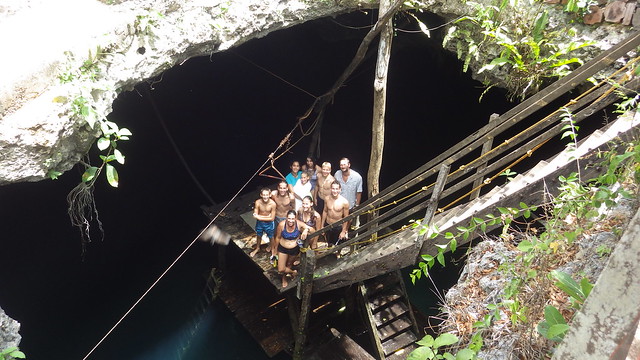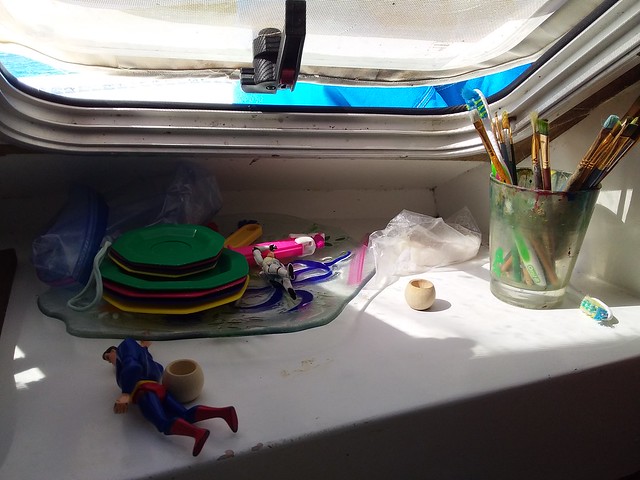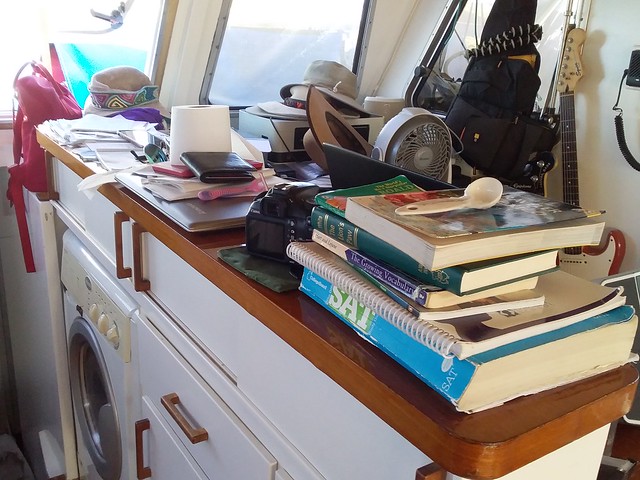One of the things I love about a traveling life is how things come full circle—sometimes literally. We are one passage (a mere 400 nautical miles as the crow flies) away from crossing our outbound March 2016 track in our circumnavigation of the Caribbean Sea. In another sense, because we keep meeting up with old friends, we complete circles in relationships—sometimes a friend to whom we’ve offered assistance ends up assisting us.
We arrived in Isla Mujeres, Mexico in early May. A year ago, we were on the Western side of Roatan, anchored conveniently near the reef where we were freediving every day in clear water. One day, a youngish guy dinghied over and introduced himself. Originally from Argentina, Joaquin is a traveler, a sailing and SCUBA instructor, a musician—and now, a friend.
After introductions and polite conversation, he asked if he could borrow a SCUBA tank. He was taking a friend diving, and the local dive shops would not rent him gear unless he was going out diving (read “paying to go out diving”) with their outfit. We lent him the tank.
When he returned it, we had another good conversation and parted, as we often do, by saying “until next time.” Next time happened to be about 9 months later in Rio Dulce, Guatemala. The boat Joaquin had been sailing on, owned by his friends, was on the hard at our marina, where he was working on it and getting it ready for sale. He had spent much of the time since we saw him last working on a wooden ship-building project in Costa Rica (a conservation-minded program called CEIBA, find it at www.sailcargo.org). We got to catch up a bit, swap travel stories, and even share some music (he’s a great harmonica player).
When we headed up to Antigua, Guatemala, at the end of March, we ran into Joaquin again. We invited him over for dinner and shared a lovely evening. He had shown us pictures of his trip up the Acatenango volcano and recommended Walter, the guide we chose for Eli and Aaron’s hike. He even (coincidentally) showed up to play live music at the restaurant where Jay and I were celebrating Jay’s 44th birthday later that week. When he mentioned he’d be heading to Mexico soon, we were pretty sure we would see him again. As it turns out, he was staying in Morelos, a small town near Cancún, and when I asked for advice about a field trip I was planning (to visit cenotes), he made a generous offer to help me plan—and even act as guide for—our outing.
We were about a dozen people from three boats coming over on the ferry for the day. Joaquin met us with a van and driver and we drove through Cancún, past all the beach hotels, and out into the wilds of the Yucatán. When Jay and I honeymooned here twenty years ago, this place was all about the beach. Sure, we went to Chichen Itzá and did some horseback riding in the jungle, but cenotes were not even “on the map.” Now, due in part to the hostile takeover of the beach by persistent Sargasso seaweed, people are looking for other ways to stay cool, and swimming in cenotes is big business.
A cenote (derived from the Mayan word for “well”) is basically a place where rainwater has dissolved limestone bedrock to expose groundwater—in Florida we would call it a sinkhole. In Mexico, it is a sacred watering hole that sustained the people and the animals of the Yucatán for thousands of years. The water is cold and clear, purified as it trickles though porous rock or runs through underground channels. Cenotes were believed to be an opening to the underworld, and there is archeological evidence that sacrifices were made in some of them to the Mayan rain God, Chaac. Some of them are “open” so that you can see the wide circular opening and others are “closed,” meaning a cave with water in it, often accessible through a small opening. There are thousands of them in Mexico. Some are still quiet little places in the middle of the jungle, but the ones near Cancun are popular with tourists. The wilderness has a paved road now, with good signage, and entrance fees.
So, given that ours would be a day-trip, we drove about an hour away, down the “Ruta de Los Cenotes” and went for a swim. Joaquin, ever the thoughtful guide, wanted to make sure we got something from—and gave something back to—the experience. As a community of long-term travelers, we are more than tourists with a vacation mentality; we are visitors and observers, aware of our impact on fragile environments and communities. Instead of buying plastic-packaged snacks, for example, we stopped at a local fruit-vendor to buy natural goodies. And conversations throughout the day centered on the history of these sacred places, the pros and cons of development, the economic and cultural impact of tourism, the thoughtless destruction of nature, and what we can do about it during our short lives on earth. Of course, in addition to these more serious thoughts, there was plenty of monkeying around, both figuratively and literally.
We arrived early to Cenote Verde Lucero, nearly the only visitors in this quiet place. The spider monkeys were still out and about, and we were warned not to leave snacks where they could be snatched. It was a beautiful place—it was easy to ignore the deck, the stairs, the picnic tables, and other signs of tourism—and see only the mirror of sky in a fresh water pool fringed by trees in the littoral forest. After the initial quiet of observation, the kids made the most of the cool water—shattering the surface of the mirror by jumping in from the top of the steep sides, dropping in from the zipline, and shaking each other off the rope suspended across the cenote.
With masks and fins, some of the kids explored the cenote and discovered that the middle was shallower than the sides (evidence of roof-material from a cave-in) and that there were small fish hiding among the rocky ledges and tree roots. I paddled around, taking pictures, laughing at the kids’ antics, and admiring the trees, which were thirstily reaching down the steep sides of the cenote for a drink of water.
After swimming, we came up for snacks. We had carefully hidden all our fruit and drinks, but it turns out the monkeys had grown bold with all the tourists, and they weren’t merely reaching into bags—they would come up to the table and snatch whatever they could find, right in front of us. They caught us by surprise while we were snacking, and we lost a bunch of small bananas before we scrambled to hide the rest. Rachel, having had a bad experience with spider monkeys (see “When Monkeys Attack,” December 2017), quickly retreated to a safe distance.
We took a short walk through the littoral forest, remarking how similar the flora looks to that of south Florida, and then turned back toward the cenote. A large group had arrived and was noisily entering the cenote—a couple dozen people in orange life jackets. We beat a hasty retreat.
On the way out, we noted, off to the side, a clearing in the center of which lay a “temazcal”—a Lakota sweat lodge where people can come for purification ceremonies. The spiritual significance of the cenote may have changed in the last five hundred years, but there is still a sense that the place is sacred, and an acknowledgment that fresh water in a hot place is life-giving and precious.
We went next to a closed cenote, La Noria. It was removed from the main road by a long and bumpy dirt path, a promising sign that things hard-to-get-to are less-frequented. It was nearly noon when we got there, and the sun was directly overhead, perfect timing for the light in the cave. Once again, we were nearly the only people there, and after we arrived, the other small group left and we had the place to ourselves. There were two entrances, one a small tunnel into which descended a spiral staircase, and another bigger opening in the cave roof.
Inside, it was beautiful, with its reflections of stalagtites in the water, bats flitting around, and clear, cold water lit only by a column of sunlight from the narrow entrance. It was a stark contrast to the wide, sunlit swim of the morning.
Once again, some of the kids donned masks and fins and explored beneath the surface, and several of them jumped into the water through the skylight. I was interested again by the appearance of tree roots—some reaching through twenty-five feet of limestone in search of moisture. Without sun exposure, the water was cold, and we swam until our teeth chattered.
Afterwards, we went to Morelos for lunch—Joaquin knew a local place with good food. It always makes me happy to hear my kids ordering confidently in Spanish. We then went for a short walk on the beach—noting the rafts of sargassum that clog the shoreline and rot in the sun. More conversations ensued—what kinds of change we can and cannot control, the growing awareness among young people of a need to take care of the environment, but also our own joy and gratitude in the face of these difficulties. It had been a wonderful day—perfect weather, good friends, cool, clear water, food, and fun. We parted, as always, with the acknowledgment that our lives are transient, and though goodbyes are frequent, so are the serendipitous reunions.















